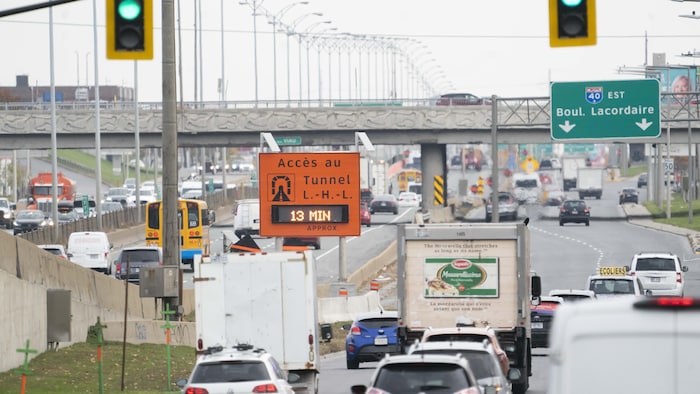In Quebec, the transportation sector remains the main contributor of greenhouse gases.

Open in full screen mode
Car traffic on a highway in Montreal. In 2021, GHG emission levels were lower than pre-pandemic levels, but slightly higher compared to 2020, indicates a report from the Quebec government published Wednesday. (Archive photo)
The Canadian Press
Voice synthesis, based on artificial intelligence, allows you to generate spoken text from written text.
In 2021, the province recorded levels of greenhouse gas (GHG) emissions lower than those recorded before the pandemic, but higher than 2020, according to the report on the reduction target of the Government of Quebec made public Wednesday.
Quebec released 77.6 million tonnes of carbon dioxide equivalent into the atmosphere in 2021, a drop of 5.6% compared to 2019, which was the last pre-pandemic report.
However, we observe a slight rebound compared to 2020, a year where several health measures slowed the economy and where Quebecers released 74 megatons into the atmosphere.
The government's report indicates that Quebec has remained first in Canada in terms of GHG emissions per person, with 9 tonnes of CO2 equivalent (t CO2 eq.) per inhabitant, or half the rate for #x27;all of Canada, established at 17.5 t eq. CO2.
The transport sector is still the main contributor of GHGs.
Loading
“The time is serious,” says the Inter-Union Common Front to the Legault government
ELSEWHERE ON INFO: “The situation is serious”, says the Inter-union Common Front to the Legault government
In 2021, it generated 33 Mt eq. CO2, or 42.6% of total emissions. The report on the reduction target, however, highlights that in 2021, emissions from this sector are below the pre-pandemic level. They therefore decreased by 7.9% compared to 2019.
The industrial sector is the second largest emitter with 25 Mt eq. CO2, accounting for 32.3% of total emissions.
Emissions from the industrial sector have decreased by 22% since 1990, according to the report.< /p>
Agriculture follows in third place, with 8.1 Mt eq. CO2, or 10.4% of GHG emissions.
Residential, commercial and institutional buildings (heating) come fourth with 7.0 Mt eq. CO2, or 9.1% of emissions.
The residual materials sector, which has been declining in recent years, contributes 4 Mt eq. CO2 (5.2%).
In 2015, after the Paris Agreement, Quebec set itself the mission of reduce GHG emissions by 37.5% compared to their 1990 level.
In light of this report, emissions decreased by 8.9% in the territory between 1990 and 2021. This inventory does not take into account data from the market carbon; if these were compiled, we would observe a more marked reduction in GHGs.
The data for the year 2022 are not yet completely recorded , but government officials who presented the report on Wednesday predict, for the first time, a reduction in fuel consumption linked to a reduction in the number of thermal vehicles in 2022.
Despite the drop in GHG emissions expected in the transport sector, officials forecast a 1.4% increase in emissions in 2022, compared to 2021. This increase is notably explained by the resumption of certain economic activities that had been slowed down during the pandemic.

